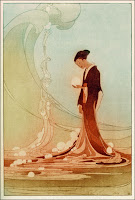You were all on a ship headed to the continent of El Sur. You didn’t make it there.
Instead, you have woken up on a strange beach of black sand and dark water, the sun too large and too red on the western horizon. You have nothing but the salt-crusted clothes on your back, and the following items that washed up with you. You can take as much or as little as you want, but you can only take what you can carry and you have to share with everybody else. Assume you have as many bags, packs, and pouches as you need to haul this stuff around.
We are using this encumbrance system. You do not know the next opportunity you will have resupply.
Weapons
- The sword: d8 damage, +1 damage if wielded with 2 hands
- The spear: d6 damage, 2 handed, a reach weapon
- The bow: d6 damage, 120′ range, two handed, comes with 18 arrows
- The sling: d4 damage, 60′ range, one handed, you can always find ammunition
- The stave: d4 damage, lets you cast a random 5e cantrip (nothing that sheds light, all damage dice are reduced by 1 step) one every 10 minutes (1 Turn)
- The daggers: d4 damage, can make two attacks if you’re wielding both
- The axe: 1d10 damage, two handed
- The bomb: 40′ range, everything within 20′ takes 4d6 damage when it goes off
Armor
- The yellow baldric: +1 AC, +1 to saves vs poison
- The patched hide: +1 AC
- The rusted chain: +2 AC, encumbers
- The piecemeal plate: +3 AC, encumbers moderately
- The shield: +1 AC, requires a free hand
- The black, fur-trimmed robe: +2 to saving throws versus magic
- The blue silk robe: +1 to all saving throws
- The red vestments: +3 AC vs Chaotic creatures
Equipment
- Book: The Seraphic Atlas (+1 to Metaphysics checks)
- Book: A Child’s Guide to the Wild (+1 to Nature checks)
- Book: A Catalogue of Human Failure (+1 to History checks)
- A holy rite (Turn Chaos as a 2nd level cleric 1/day)
- lockpicks (required to make Pick Locks)
- pot of ointment (heal 1d4 HP. Has 1d10 doses)
- 100′ of rope
- grappling hook and 25′ of rope
- Doctor’s bag (required to make Medicine checks)
- Poisoner’s pack (required to make Poison-making checks)
- Disguise kit (required to make Disguise checks)
- 10 hard biscuits
- 10 full waterskins
- a lantern
- 6 flasks of oil
- 6 torches
- ghost food (can be used as a medium offering to any god)
- a 1 pound block of lard
- a flute
- a dozen metal spikes
- A lighter
- A pack of cigarettes
- a bottle of rum
- a flare gun
- a pouch with 6 strange coins
- A beautiful ruby ring
- A cloth doll



